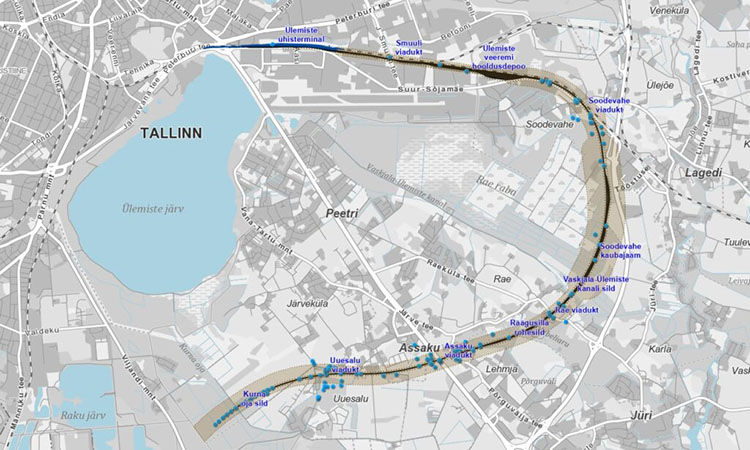Rail Baltica main route in Estonia meets EIA requirements
Posted: 8 August 2022 | Elliot Robinson (Editorial Assistant - Global Railway Review) | No comments yet
An environmental impact assessment report has declared the Ülemiste-Kangru section of Rail Baltica to be compliant with requirements.


A map showing the the Ülemiste-Kangru section of Rail Baltica Estonia - Credit: Rail Baltica
The Consumer Protection and Technical Regulatory Authority declared the environmental impact assessment (EIA) report of the Ülemiste-Kangru section of Rail Baltica to be compliant with the requirements. The recognition of the EIA report as meeting the requirements will soon allow the construction of the first section of the main railway line to begin.
The route section running from the Ülemiste terminal to Kangru township is 15.8 kilometres long, and the railway corridor runs there mainly between business and production areas, and between promising compact built-up areas. There are no large forest areas, agricultural areas or land units in the area, and there are no Natura 2000 areas within the influence area of the railway.
“When it comes to various measures, for example, in order to reduce railway noise, various noise barrier solutions will be built on the section for nearly three kilometres, wooden or metal noise barrier walls and earth embankments,” Roland Müür, Environmental Manager for Rail Baltic Estonia, said. “In order to ensure the movement of fauna, one eco-duct is planned for the section, as well as an underpass suitable for big game, sixteen culverts and tunnels for small animals. In addition, green strips will be built on the edge of three viaducts crossing the railway.”
The environmental impact assessment report also sets important conditions for carrying out construction activities, to protect the bird population, the forest along the route will be cut down outside the birds’ breeding season, and if necessary, time restrictions will also be applied to construction activities. In addition, the water level and quality of the wells that remain in the affected area during construction activities must be ensured, and construction materials must be transported and stored in a way that minimises the spread of dust. The implementation of the measures and the effectiveness of the measures will be monitored by mandatory monitoring during the entire construction period as well as during the period of use of the future railway.
Related news you will enjoy:
Rail Baltica announce railway electrification procurement
Over €350 million awarded to Rail Baltica in first call of new financial period
Rail Baltica study offers recommendations for synergies along railway corridor
Considering the large number of environmental measures and the complexity of the project, Rail Baltic Estonia will prepare a corresponding environmental management plan for the management of environmental measures for each section to be assessed. The environmental management plan will include both the environmental measures made mandatory when the permit was issued, as well as the environmental measures set voluntarily by the developer. The environmental management plan is updated regularly (either once a year or more frequently according to the important developments of the project) by adding or specifying measures according to changes in environmental information or the development of other improved knowledge.
The environmental impact assessment of the Estonian part of Rail Baltica is carried out in parallel with the design of the main route. Important impact areas assessed by the EIA: wildlife, noise, energy use, cultural heritage, ambient air, surface water, groundwater, etc.
The initiation of the impact assessment was requested by the Estonian branch of RB Rail AS at the beginning of 2019 on its own initiative.
OUT NOW: The Definitive Guide to Rail’s Digital Future
The rail industry is undergoing a digital revolution, and you need to be ready. We have released our latest market report, “Track Insight: Digitalisation.”
This is not just another report; it’s your comprehensive guide to understanding and leveraging the profound technological shifts reshaping our industry. We move beyond the buzzwords to show you the tangible realities of AI, IoT, and advanced data analytics in rail.
Discover how to:
- Optimise operations and maintenance with real-time insights.
- Enhance passenger services through seamless, high-speed connectivity.
- Leverage technologies like LEO satellites to improve safety and efficiency.
Featuring expert analysis from leaders at Nomad Digital, Lucchini RS, Bentley Systems and more, this is a must-read for any rail professional.
Related topics
Infrastructure Developments, Regulation & Legislation, Route Development, Sustainability/Decarbonisation
Related organisations
Rail Baltica/RB Rail AS, The Consumer Protection and Technical Regulatory Authority







